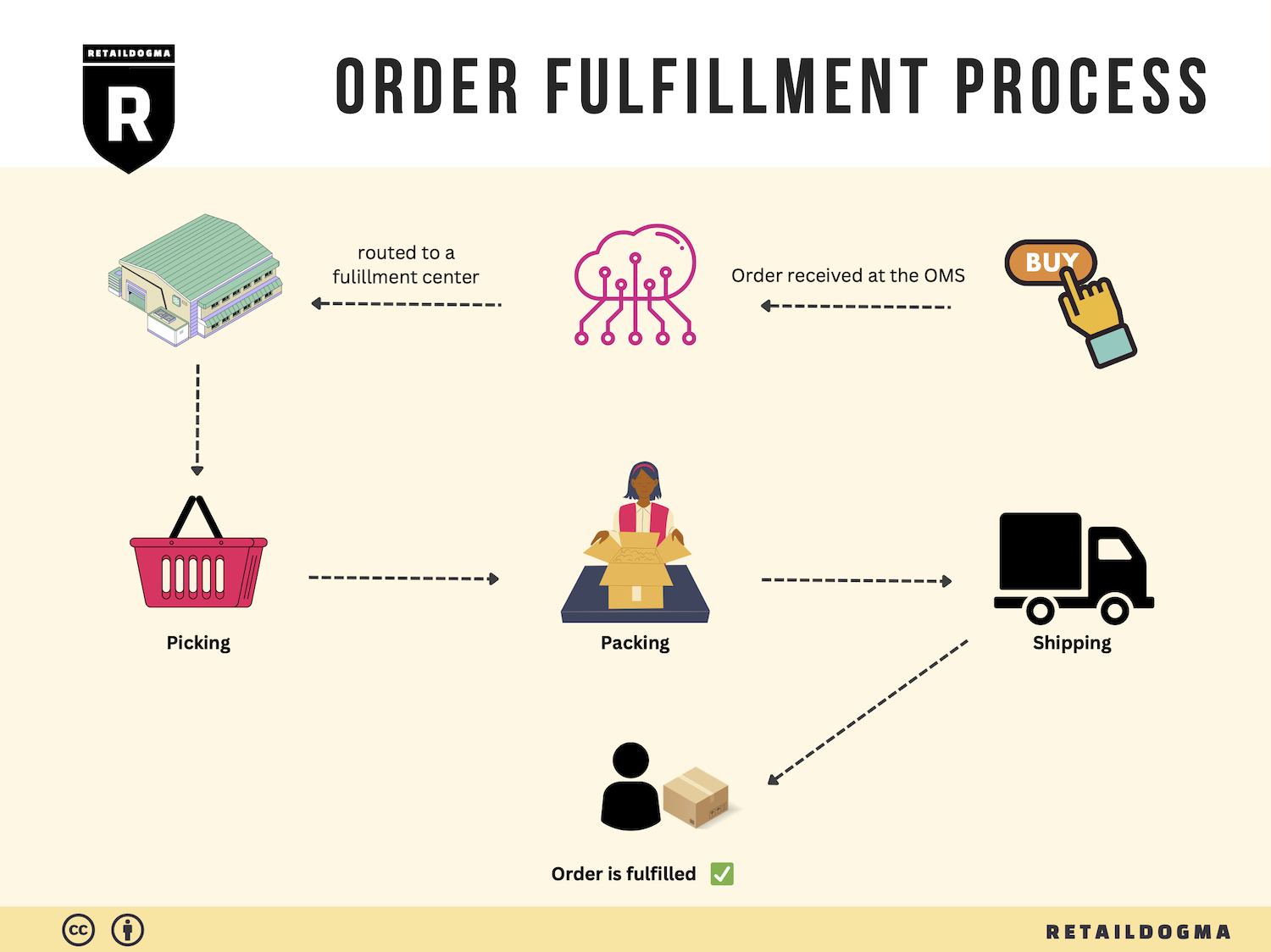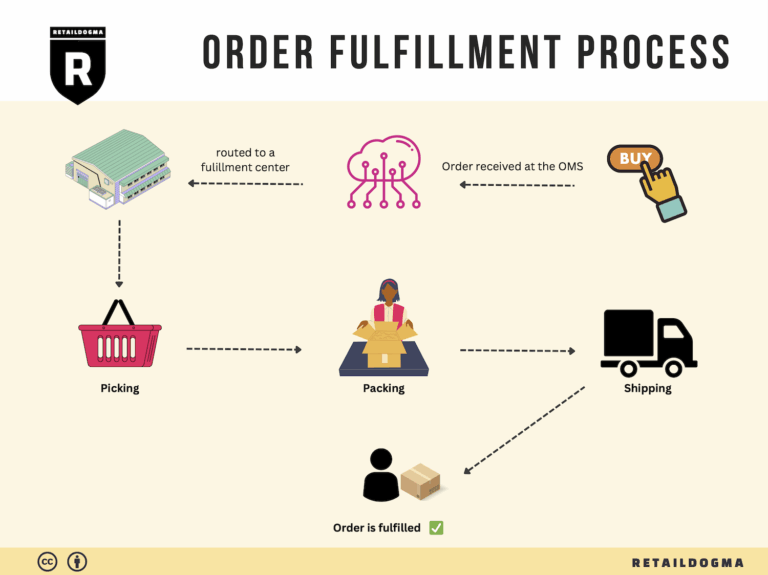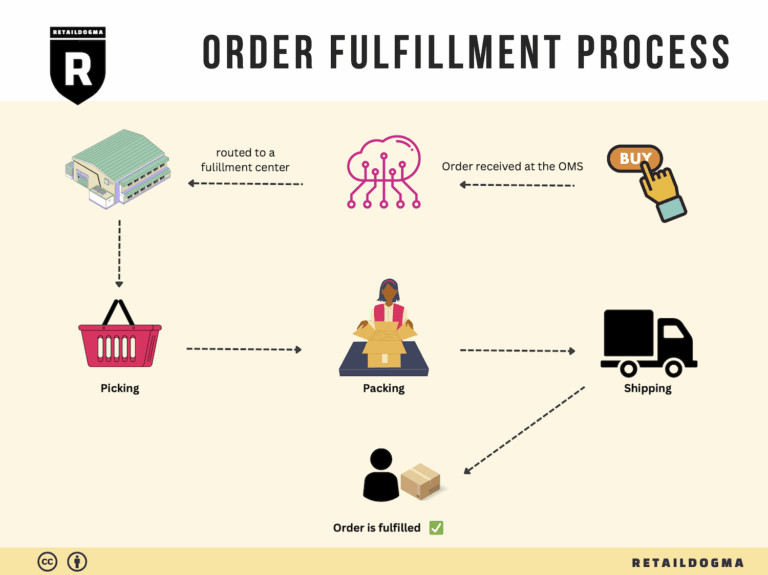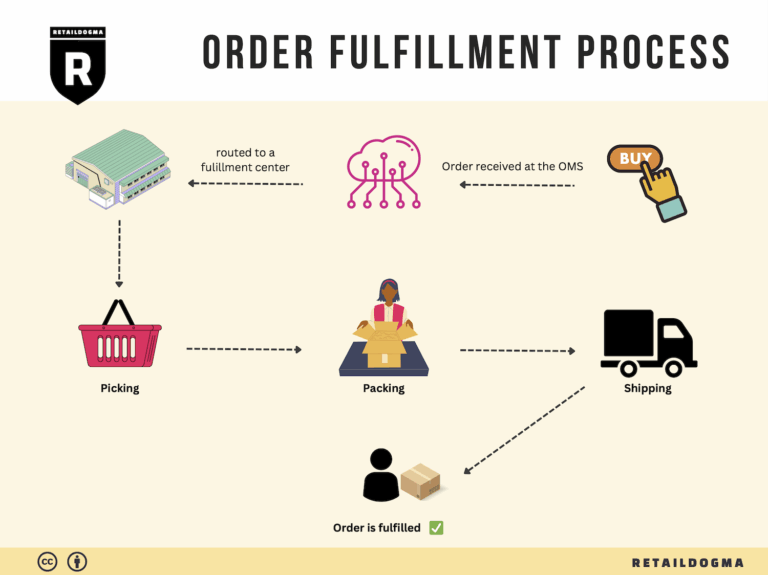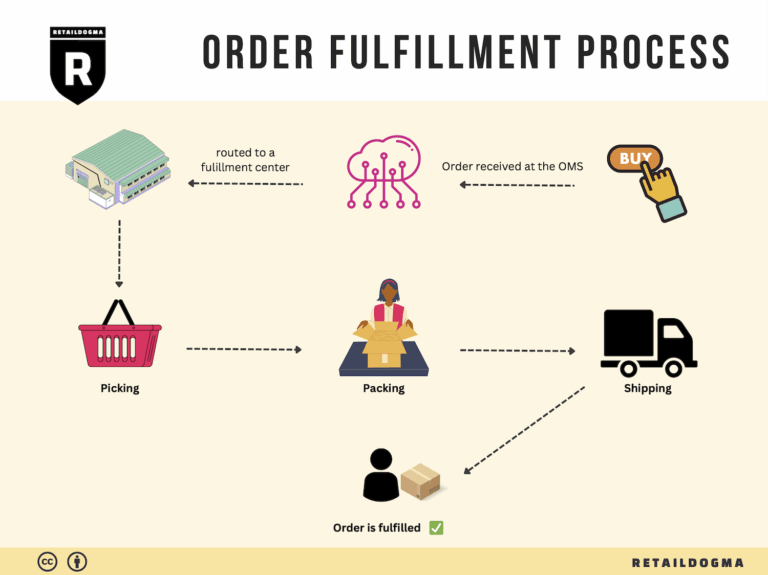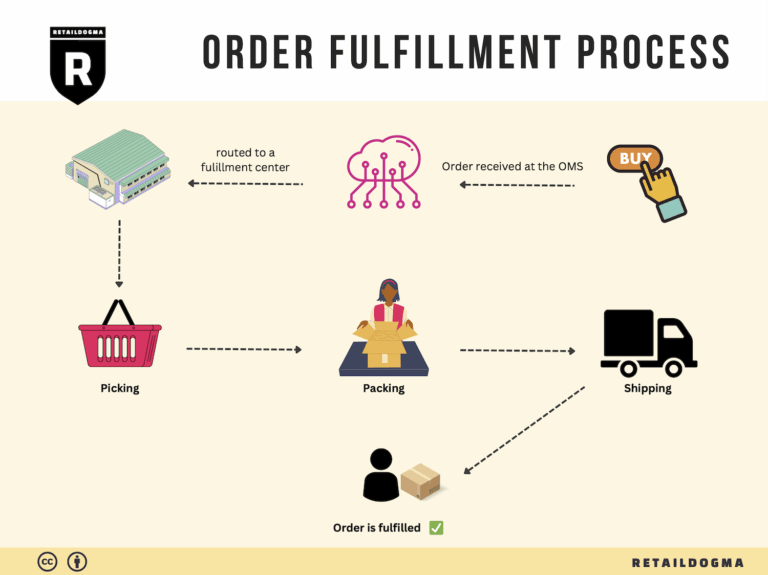Ecommerce Fulfillment Services: The Ultimate Guide (2025)
What is E-commerce Fulfillment? An Introduction for Growing Businesses
Understanding the Challenges of E-commerce Fulfillment
As an e-commerce business owner, you may find yourself grappling with the complexities of packing and shipping orders. The excitement of making sales can quickly turn into a logistical nightmare when faced with overwhelming order volumes, inventory management issues, and the pressure to meet customer expectations for fast and reliable delivery. This is where effective e-commerce fulfillment comes into play.
At its core, fulfillment refers to the entire process of getting a product from your inventory to the customer’s doorstep. This includes everything from receiving orders and picking items from your warehouse to packing them securely and arranging for their shipment. A streamlined fulfillment process is crucial for scaling your business, enhancing customer satisfaction, and ultimately driving revenue.
What This Guide Will Cover
In this guide, we will explore various fulfillment models that can support your growing business. We’ll dive into options like Third-Party Logistics (3PL) and Fulfillment by Amazon (FBA), highlighting their benefits and potential drawbacks. Understanding these models will help you determine which approach aligns best with your business needs.
We will also cover the core services involved in e-commerce fulfillment, including inventory management, order processing, packing, shipping, and returns handling. Each of these components plays a vital role in ensuring that your customers receive their orders accurately and on time.
Selecting the right fulfillment partner can be daunting. This guide will provide you with practical tips on what to look for in a logistics partner, such as their technology capabilities, scalability, and customer service track record. Additionally, we’ll discuss pricing structures and how to assess the total cost of fulfillment to ensure it fits within your budget while still meeting your service level expectations.
Empowering Your Business Decisions
Our goal with this guide is to empower you, the business owner, to make informed and strategic decisions about your logistics. With the right fulfillment strategy in place, you can not only alleviate the stress of order management but also position your business for sustainable growth in the competitive e-commerce landscape. Whether you’re just starting out or looking to optimize your existing operations, understanding the intricacies of e-commerce fulfillment is essential for your success.
What You’ll Learn In This Guide
- What is E-commerce Fulfillment? An Introduction for Growing Businesses
- The Order Fulfillment Process: From ‘Buy’ Button to Customer’s Door
- Comparing Fulfillment Models: In-House vs. 3PL vs. Dropshipping
- A Deep Dive into Amazon FBA: Pros, Cons, and Who It’s For
- Core Services Offered by Fulfillment Centers
- How to Choose a Fulfillment Partner: A 6-Point Checklist
- Understanding Fulfillment Pricing: A Breakdown of Common Fees
- Frequently Asked Questions (FAQs) about Fulfillment
- Conclusion: Is Outsourcing Fulfillment the Right Move for Your Business?
- Important Disclaimer
The Order Fulfillment Process: From ‘Buy’ Button to Customer’s Door
1. Receiving Inventory
The order fulfillment process begins with receiving inventory, a critical step that sets the foundation for efficient operations. When products arrive at a fulfillment center or store, they undergo a thorough inspection to ensure accuracy and quality. This includes checking against purchase orders to verify quantities and identifying any damaged items.
This step is vital because accurate receiving directly impacts inventory accuracy, which is essential for fulfilling customer orders. A well-implemented receiving process minimizes discrepancies and reduces the risk of stockouts or overstock situations. A key term associated with this step is SKU (Stock Keeping Unit), a unique identifier that helps track inventory levels and streamline the receiving process.
2. Warehouse Storage
Once inventory is received, it needs to be organized and stored effectively. This involves placing products in designated locations within the warehouse or store, ensuring that high-demand items are easily accessible. Efficient storage systems, such as bin shelving or pallet racking, optimize space and facilitate quicker order fulfillment.
Proper warehouse storage is crucial as it influences the speed of order picking later in the process. An organized storage system reduces the time spent searching for products, thereby enhancing overall efficiency. The key term here is FIFO (First In, First Out), a method used to manage inventory that ensures older stock is sold before newer stock, minimizing the risk of obsolescence and waste.
3. Order Picking
The next step in the fulfillment process is order picking, where items are selected from their storage locations based on customer orders. This task can be carried out using various methods, including single order picking (one order at a time) or batch picking (multiple orders simultaneously).
Efficient order picking is critical to maintaining fast turnaround times and customer satisfaction. Errors during this stage can lead to incorrect shipments, resulting in returns and increased operational costs. A key term associated with order picking is pick lists, which are documents or digital interfaces that outline the items and quantities needed for each order, guiding employees through the picking process.
4. Order Packing
After picking, the next step is packing the orders for shipment. This involves carefully placing items into boxes or shipping containers, ensuring they are secure and protected during transit. Proper packing not only safeguards the products but also enhances the customer experience by presenting a professional appearance upon delivery.
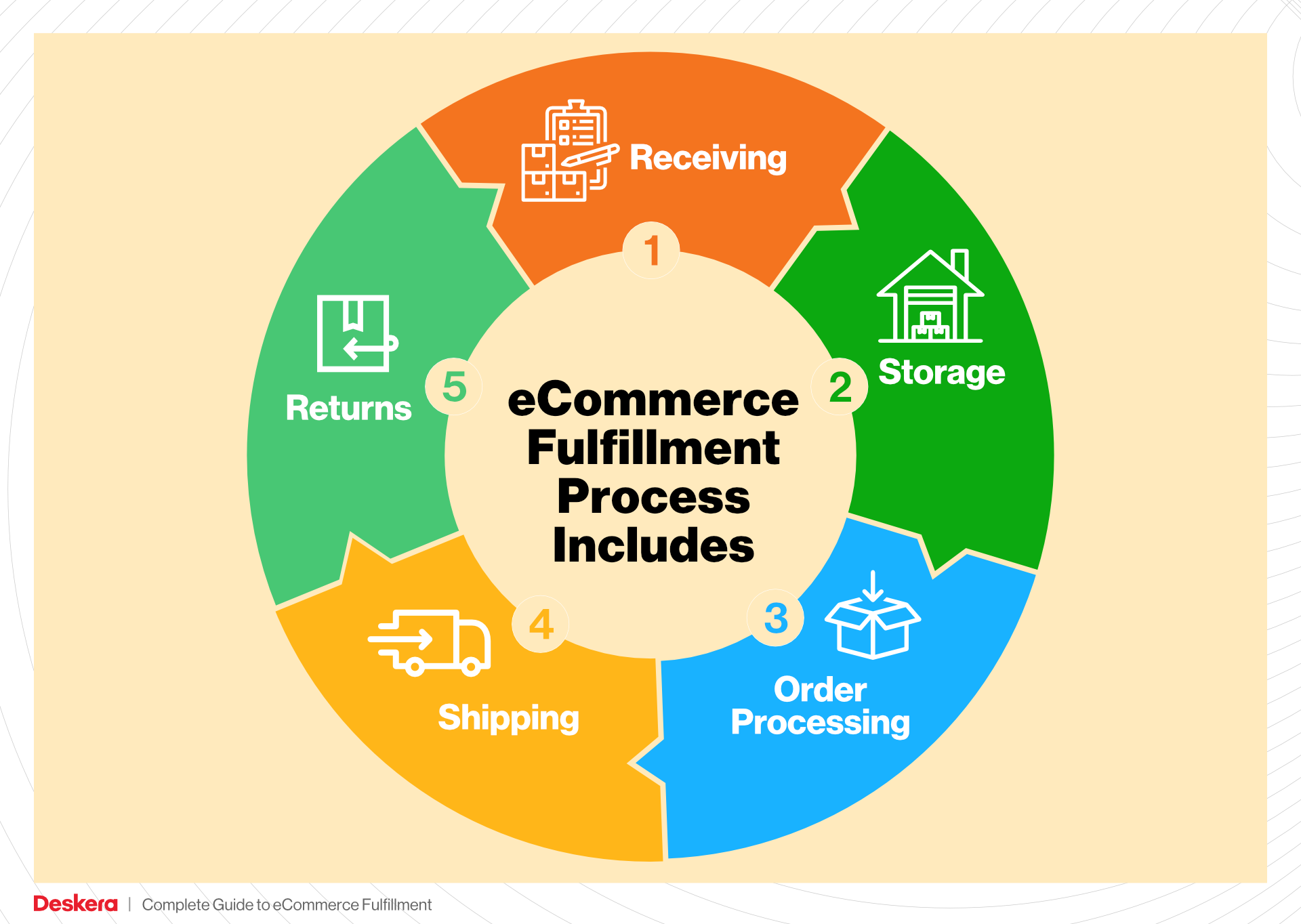
Effective packing is essential for minimizing shipping costs and reducing the likelihood of damages during transportation. Additionally, it allows for the inclusion of necessary documentation, such as packing slips or return instructions. The key term here is dimensional weight, which refers to a pricing technique used by shipping carriers that considers the volume of a package in addition to its weight, making efficient packing crucial for cost management.
5. Shipping & Delivery
The final step in the order fulfillment process is shipping and delivery. Once orders are packed, they are labeled and dispatched to the appropriate carriers for transportation to the customer’s location. This step involves selecting the most efficient shipping methods based on factors such as cost, delivery speed, and customer preferences.
Timely shipping and delivery are paramount for customer satisfaction and retention. Delays can lead to dissatisfaction and negatively impact a brand’s reputation. A key term associated with this stage is last-mile delivery, which refers to the final leg of the shipping process where the package is delivered from a transportation hub to the customer’s doorstep. Optimizing last-mile delivery can significantly enhance the overall fulfillment experience.
In conclusion, mastering each step of the order fulfillment process is essential for e-commerce businesses seeking to scale their operations. By focusing on accuracy and efficiency from receiving inventory to shipping and delivery, businesses can improve customer satisfaction, reduce operational costs, and build a competitive edge in the market.
Comparing Fulfillment Models: In-House vs. 3PL vs. Dropshipping
Fulfillment Models Comparison
| Model | Who Handles Inventory | Best For (Business Stage) | Key Advantage | Key Disadvantage |
|---|---|---|---|---|
| In-House Fulfillment | The business itself | Established businesses with stable sales | Full control over inventory and operations | Higher operational costs and complexity |
| Third-Party Logistics (3PL) | A third-party provider | Growing businesses seeking scalability | Cost efficiency and expertise in logistics | Less control over inventory and fulfillment process |
| Dropshipping | Supplier or manufacturer | Startups and businesses testing markets | Low upfront investment and risk | Lower profit margins and less control over product quality |
In-House Fulfillment
In-house fulfillment is a model where businesses manage their own inventory and logistics operations. This approach is typically favored by established companies that have stable sales and sufficient capital to invest in warehousing, staffing, and technology. The primary advantage of in-house fulfillment is the level of control it provides. Businesses can oversee every aspect of inventory management, from procurement to storage and shipping, ensuring that they maintain quality standards and respond quickly to customer demands. However, the key disadvantage is the complexity and cost associated with running these operations. Managing logistics requires investment in infrastructure, technology, and human resources, which can strain financial resources, especially for smaller businesses. Additionally, as order volumes increase, the challenge of maintaining efficiency and accuracy in fulfillment processes can become daunting.
Third-Party Logistics (3PL)
Third-party logistics (3PL) is a fulfillment model where businesses outsource their logistics needs to specialized providers. This model is particularly beneficial for growing businesses that require scalability without the burdens of managing logistics directly. 3PL providers handle inventory storage, order processing, and shipping, allowing businesses to focus on core activities such as marketing and product development. The key advantage of this model is cost efficiency; businesses can leverage the expertise and infrastructure of 3PL providers without the need for significant capital investment in logistics. However, this model does come with some drawbacks. Businesses relinquish some control over their inventory and fulfillment processes, which can lead to challenges in maintaining quality and consistency. Moreover, if the 3PL provider fails to meet service expectations, it can negatively impact customer satisfaction and brand reputation.
Dropshipping
Dropshipping is a fulfillment model where the retailer does not keep goods in stock. Instead, when a customer places an order, the retailer purchases the item from a third-party supplier who then ships it directly to the customer. This model is ideal for startups and businesses testing new markets, as it requires minimal upfront investment and reduces the financial risk associated with carrying inventory. The primary advantage of dropshipping is that it allows businesses to offer a wide range of products without the need for significant investment in inventory. However, there are notable disadvantages, including lower profit margins due to reliance on suppliers and limited control over product quality and shipping times. Additionally, if the supplier fails to fulfill orders accurately or on time, it can harm the retailer’s reputation and customer relationships.
Conclusion
Choosing the right fulfillment model is crucial for e-commerce businesses, as it directly impacts operational efficiency, customer satisfaction, and overall profitability. Each model—In-House Fulfillment, Third-Party Logistics, and Dropshipping—has its own unique advantages and disadvantages, making them suitable for different business stages and objectives. Understanding these nuances can help entrepreneurs and operations managers make informed decisions that align with their growth strategies and market demands.
A Deep Dive into Amazon FBA: Pros, Cons, and Who It’s For
Understanding Fulfillment by Amazon (FBA)
Fulfillment by Amazon (FBA) is a service that enables e-commerce sellers to store their products in Amazon’s fulfillment centers. Amazon then takes care of storage, packaging, and shipping of products directly to customers. Sellers benefit from Amazon’s extensive logistics network, allowing them to focus on growing their businesses while leveraging Amazon’s reputation and customer service capabilities.
How FBA Works
-
Product Listing: Sellers create product listings on Amazon and enroll their products in FBA.
-
Inventory Shipment: Sellers send their products to Amazon’s fulfillment centers. These centers are strategically located to ensure efficient shipping to various regions.
-
Storage: Once the products arrive, they are stored in Amazon’s warehouses. Amazon uses sophisticated inventory management systems to track stock levels.
-
Order Processing: When a customer places an order for a product listed under FBA, Amazon picks, packs, and ships the item on behalf of the seller.
-
Customer Service: Amazon handles all customer inquiries and returns, ensuring a seamless experience for buyers.
-
Payment: After the product is sold, Amazon deducts fees and transfers the remaining amount to the seller’s account.
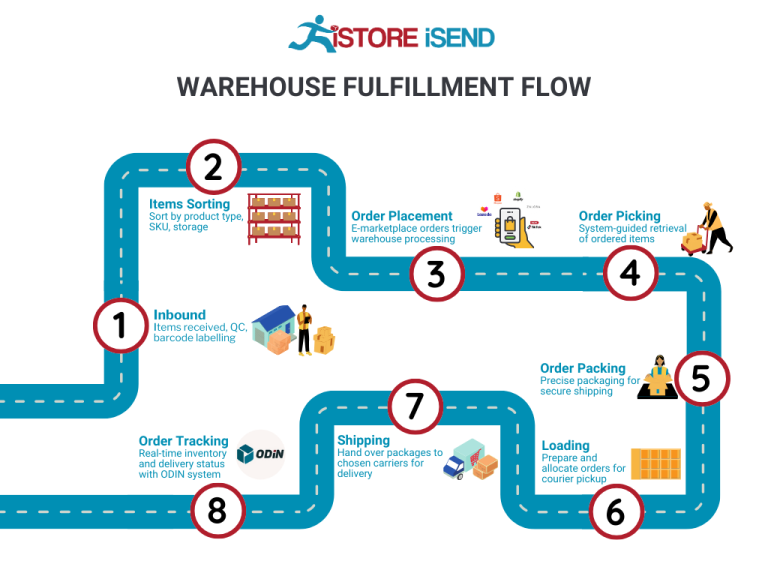
Pros of Using FBA
1. Prime Eligibility
One of the most significant advantages of FBA is the eligibility for Amazon Prime. Products fulfilled by Amazon are marked with the Prime badge, making them more attractive to millions of Prime members who prioritize fast, free shipping. This can lead to increased sales as Prime members are more likely to purchase products that qualify for their membership benefits.
2. Customer Trust
Amazon’s established reputation as a reliable retailer extends to sellers using FBA. Customers often feel more secure purchasing products fulfilled by Amazon due to their trust in Amazon’s customer service and return policies. This trust can enhance conversion rates and reduce cart abandonment.
3. Multi-Channel Fulfillment
FBA isn’t limited to sales on Amazon alone. Sellers can use FBA to fulfill orders from their own websites or other marketplaces, allowing them to centralize their inventory management. This flexibility can streamline operations and reduce logistics costs.
4. Scalability
FBA allows businesses to scale quickly without the need to invest heavily in logistics infrastructure. Sellers can leverage Amazon’s fulfillment capabilities to expand their reach, especially during peak seasons when demand surges.
5. Inventory Management
Amazon’s sophisticated inventory management systems help sellers keep track of stock levels and optimize supply chain operations. This reduces the risk of stockouts or overstocking, which can be detrimental to cash flow.
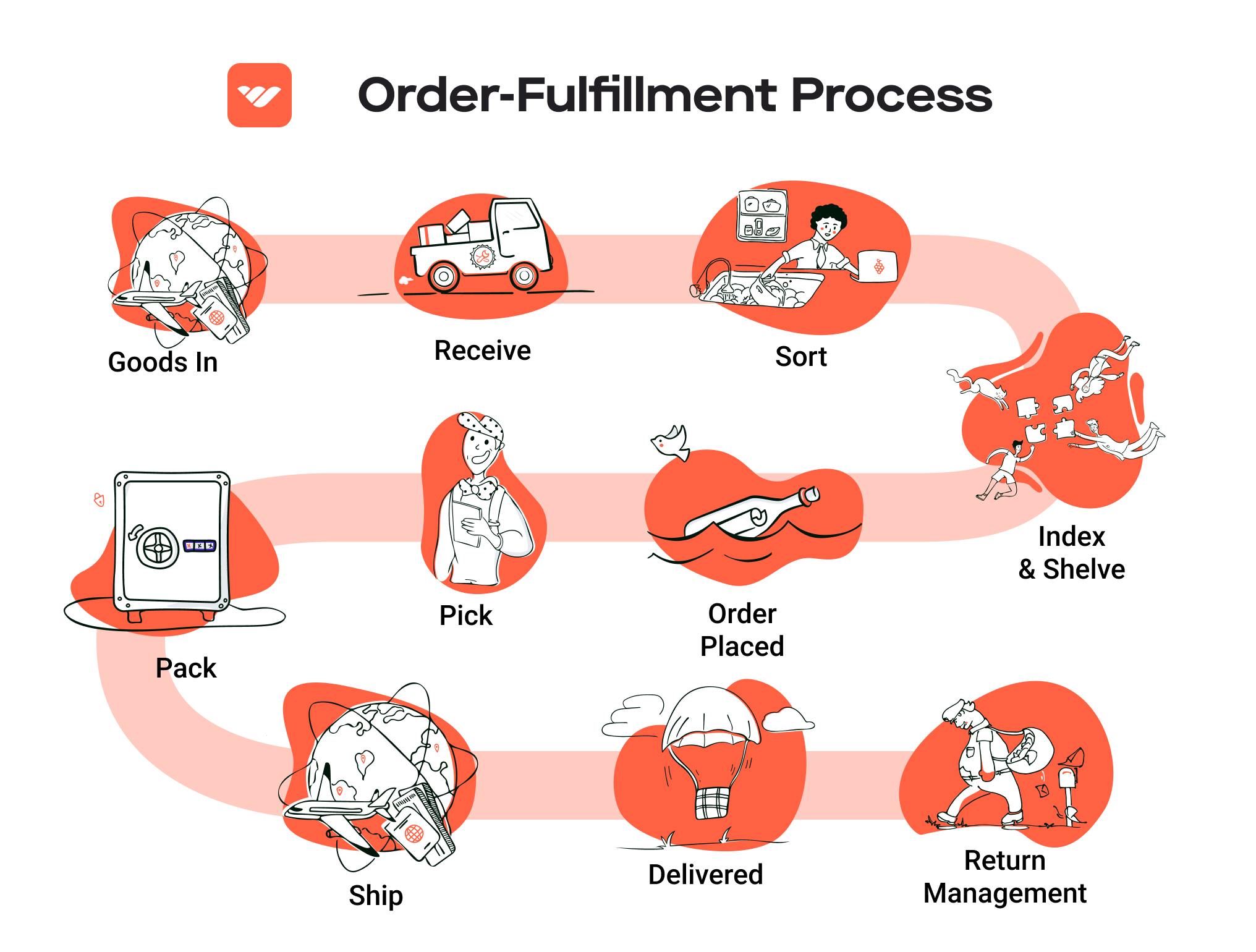
Cons of Using FBA
1. High Fees
While FBA provides numerous benefits, the associated costs can be significant. Sellers incur storage fees based on the amount of inventory stored in Amazon’s warehouses, as well as fulfillment fees for each unit sold. These costs can add up quickly, particularly for low-margin products, impacting profitability.
2. Strict Inventory Rules
Amazon has stringent rules regarding inventory management. Sellers must ensure that their products meet Amazon’s quality standards, and failure to comply can lead to penalties, including account suspension. This can create additional pressure on sellers to maintain high operational standards.
3. Commingling Risks
When using FBA, sellers’ inventory may be commingled with that of other sellers. This means that if a customer receives a defective or unsatisfactory product, it can be challenging to ascertain which seller is responsible. This risk can damage a seller’s reputation, especially if they are unfairly associated with poor-quality products.
4. Loss of Control
By outsourcing fulfillment to Amazon, sellers relinquish a degree of control over the shipping and customer experience. Issues like packaging, branding, and shipping times may not align with the seller’s standards, potentially affecting customer satisfaction.
5. Inventory Limitations
Amazon imposes limits on the amount of inventory that can be stored in their warehouses, especially for new sellers or those with low sales velocity. This can restrict growth opportunities and complicate inventory management for sellers looking to scale.
Who is FBA Best For?
Fulfillment by Amazon is particularly advantageous for:
-
Small to Medium-Sized Businesses: These businesses may not have the resources to build their own fulfillment infrastructure. FBA allows them to leverage Amazon’s logistics network without significant upfront investment.
-
Sellers with High-Volume Products: For products with high turnover rates, the benefits of FBA can outweigh the costs. The increased visibility and sales potential through Prime eligibility can drive significant revenue.
-
Brands Looking to Enhance Trust: If a brand is new or struggling with customer trust, FBA can provide a boost by associating the products with Amazon’s reliable service.
-
Multi-Channel Sellers: Businesses that sell on multiple platforms can streamline operations through FBA, allowing for consistent inventory management and fulfillment across channels.
-
Seasonal Businesses: Companies that experience peak demand during specific times of the year can benefit from FBA’s scalability, as they can ramp up inventory without the need for additional logistics investments.
In conclusion, while Fulfillment by Amazon offers robust solutions for e-commerce sellers looking to simplify logistics and enhance sales, it is essential for businesses to carefully weigh the pros and cons. Understanding the specific needs and capabilities of your business will help determine whether FBA is the right fit for your growth strategy.
Core Services Offered by Fulfillment Centers
Inventory Management & Warehousing
Inventory management is the backbone of any successful e-commerce operation, and fulfillment centers excel at this critical function. They offer sophisticated warehousing solutions that enable businesses to efficiently store and manage their products. This includes real-time inventory tracking, which allows e-commerce businesses to have an accurate view of stock levels across multiple sales channels.
The benefits of effective inventory management are multifaceted. By leveraging advanced technology such as RFID tags and barcode scanners, fulfillment centers help businesses minimize stock discrepancies and improve order accuracy. This leads to higher customer satisfaction rates, as products are more likely to be available when customers seek them. Furthermore, effective inventory management reduces the risk of overstocking or stockouts, optimizing cash flow and reducing storage costs. For e-commerce businesses looking to scale, having a reliable inventory management system is essential for maintaining operational efficiency and meeting customer expectations.
Pick and Pack Services
Pick and pack services are at the heart of the fulfillment process. This service involves selecting items from the warehouse shelves (picking) and preparing them for shipment (packing). Fulfillment centers utilize organized picking methods, such as batch picking or zone picking, to enhance efficiency and reduce the time it takes to fulfill orders.
The benefits of pick and pack services are significant for e-commerce businesses. By outsourcing this function to specialized fulfillment centers, businesses can focus on their core competencies—such as marketing and product development—while ensuring that orders are processed quickly and accurately. This not only speeds up delivery times, which is crucial for customer satisfaction, but also allows businesses to handle larger order volumes without the need for additional in-house labor. Additionally, many fulfillment centers offer customizable packing options, which can enhance branding and provide a better unboxing experience for customers.
Kitting and Assembly
Kitting and assembly services involve the grouping of individual items into ready-to-ship kits or sets. This is particularly beneficial for businesses that offer products that are frequently sold together, such as gift sets or subscription boxes. Fulfillment centers can streamline this process by assembling these kits in advance, reducing the time spent on order fulfillment.
The advantages of kitting and assembly services are clear. By pre-assembling kits, businesses can reduce fulfillment times and enhance order accuracy, leading to improved customer experiences. This service also allows for more strategic inventory management, as businesses can track the sales of kits versus individual items. Furthermore, kitting can provide an opportunity for upselling; for instance, by bundling complementary products together, businesses can increase average order values. As e-commerce companies look to differentiate themselves in a competitive landscape, kitting and assembly services can provide a unique selling proposition.
Returns Management (Reverse Logistics)
Returns management, often referred to as reverse logistics, is an essential service provided by fulfillment centers that can significantly impact customer satisfaction and overall business efficiency. This service encompasses the process of handling returned products, from receiving and inspecting items to restocking or disposing of them as necessary.
The benefits of effective returns management are substantial. In today’s e-commerce landscape, where return rates can be as high as 30% for certain categories, having a streamlined process for handling returns is crucial. Fulfillment centers can minimize the time and cost associated with returns by quickly processing them and updating inventory levels. This not only helps maintain accurate stock counts but also allows businesses to resell returned items more quickly, thus reducing potential losses.
Additionally, a well-managed returns process can enhance customer loyalty. When customers know they can easily return items without hassle, they are more likely to complete purchases. This sense of security can encourage more frequent shopping, ultimately driving sales growth. For businesses looking to improve their customer experience, investing in robust returns management services through fulfillment centers is a smart strategy.
Conclusion
In summary, fulfillment centers provide a range of core services that are vital for e-commerce businesses aiming to scale. From inventory management and warehousing to pick and pack services, kitting, and returns management, these services collectively enhance operational efficiency, reduce costs, and improve customer satisfaction. As the e-commerce landscape continues to evolve, leveraging the expertise of fulfillment centers can be a game-changer for businesses looking to thrive in a competitive market. By understanding and utilizing these core services, e-commerce entrepreneurs can focus on growth and innovation while ensuring their logistics operations run smoothly.
How to Choose a Fulfillment Partner: A 6-Point Checklist
Location & Warehouse Network
Importance:
The geographical location of your fulfillment partner’s warehouses can significantly impact shipping times and costs. A strategically located partner can help you reach your customers faster and reduce transportation expenses.
Questions to Ask:
– Where are your warehouses located, and how do they align with my customer base?
– What is your average shipping time to key regions?
– Can you provide insights into your network’s ability to scale geographically as my business grows?
Technology & Integrations
Importance:
A robust technology platform is crucial for seamless operations, from inventory management to order tracking. Your fulfillment partner should integrate easily with your existing systems (e.g., e-commerce platforms, ERPs) to ensure real-time data synchronization.
Questions to Ask:
– What technology do you use for order processing and inventory management?
– How do you handle integrations with popular e-commerce platforms like Shopify, WooCommerce, or Magento?
– Can you provide examples of how your technology has improved efficiency for your clients?
Specializations (e.g., Cold Storage, Oversized Items)
Importance:
Different products have unique storage and handling requirements. If you sell perishable goods, fragile items, or oversized products, it’s essential to partner with a fulfillment center that specializes in these areas.
Questions to Ask:
– What specific product categories do you specialize in, and what facilities do you have for them?
– Can you accommodate unique storage needs, such as climate control for perishables or special handling for fragile items?
– What are your protocols for quality control and damage prevention during storage and shipping?
Scalability & Capacity
Importance:
As your business grows, your fulfillment needs will evolve. It’s vital to choose a partner that can scale their operations to meet your increasing demand without compromising service quality.
Questions to Ask:
– How do you handle seasonal fluctuations in order volume?
– What is your capacity for handling sudden spikes in demand?
– Can you share examples of how you’ve successfully scaled operations for other clients?
Pricing and Contracts
Importance:
Understanding the pricing structure and contract terms is critical to avoid unexpected costs. Transparency in pricing helps you budget effectively and ensures you are getting value for your investment.
Questions to Ask:
– Can you provide a detailed breakdown of your pricing model (e.g., per order, storage fees, shipping costs)?
– Are there any additional fees I should be aware of (e.g., for returns, inventory management)?
– What are the terms of the contract, and is there flexibility for renegotiation as my business needs change?
Customer Support & Reviews
Importance:
Reliable customer support can make or break your fulfillment experience. A partner that provides responsive and knowledgeable support can help resolve issues quickly, minimizing disruptions to your operations.
Questions to Ask:
– What support channels do you offer (e.g., phone, email, chat), and what are your response times?
– Can you provide references or case studies from current clients?
– How do you handle customer complaints or issues, and what is your escalation process?
Conclusion
Choosing the right fulfillment partner is a critical decision that can significantly influence your e-commerce success. By using this checklist, you can ensure that you select a partner that aligns with your business needs, supports your growth, and helps you deliver exceptional service to your customers. Take the time to ask the right questions and conduct thorough research to find a fulfillment partner that can truly become an extension of your business.
Understanding Fulfillment Pricing: A Breakdown of Common Fees
Initial Setup Fees
When engaging a fulfillment service, businesses often encounter initial setup fees. These fees are typically charged to cover the costs associated with establishing your account, integrating your systems, and preparing the fulfillment center for your specific needs. This may include onboarding processes, software integration, and customizing storage solutions tailored to your products.
The calculation of initial setup fees can vary widely among providers, ranging from a flat fee to a percentage of the expected monthly sales volume. Some companies may waive these fees for larger clients or in exchange for a long-term contract commitment. As a best practice, always inquire about what is included in the setup process and any additional costs that might arise during this phase.
Receiving Fees
Receiving fees are incurred when your products arrive at the fulfillment center. These fees cover the labor and resources needed to unload, inspect, and log your inventory into the system. The fee structure can be based on a per-pallet, per-box, or per-unit basis, depending on the provider’s pricing model.
To calculate receiving fees, consider the volume of your shipments and the complexity of your inventory. For instance, if your products require special handling or additional quality checks, expect to pay higher receiving fees. Businesses should ensure clarity on how receiving fees are structured and if there are additional charges for special services.
Storage Fees (per pallet/bin)
Storage fees are charged for keeping your inventory in the fulfillment center. These fees are typically calculated on a per-pallet or per-bin basis and can vary depending on the size and weight of your products. Storage costs may also fluctuate based on the time of year; for example, demand during peak seasons (like holidays) can lead to higher storage rates.
To manage storage fees effectively, businesses should analyze their inventory turnover rates. Products with slower turnover may incur unnecessary storage costs. Consider negotiating with your fulfillment provider about volume discounts for larger storage commitments or seasonal storage solutions to optimize costs.
Pick & Pack Fees (per item/order)
Pick and pack fees are charged for the labor involved in selecting items from inventory and packing them for shipment. This fee is usually calculated on a per-item or per-order basis, with the cost increasing based on the complexity of the order. For instance, orders that require multiple items or special packaging may incur higher pick and pack fees.
To optimize these fees, businesses should streamline their order processes. Consider strategies such as bulk orders or bundling products to reduce the number of picks per order. Communicate clearly with your fulfillment provider about your typical order profiles to ensure accurate pricing and to explore potential discounts for higher volumes.
Shipping Fees
Shipping fees are among the most significant costs in fulfillment pricing and can vary based on multiple factors, including package weight, dimensions, shipping distance, and the chosen carrier. Most fulfillment centers offer multiple shipping options, from standard to expedited, each with its own pricing structure.
To calculate shipping fees accurately, businesses should be aware of their shipping profiles and volume. Consider using a fulfillment provider that offers real-time shipping rate comparisons to find the best deals. Additionally, explore options for negotiating bulk shipping rates with carriers, as many fulfillment centers can leverage their shipping volume to secure better pricing for their clients.
Tips for Getting an Accurate Quote
-
Provide Detailed Information: When seeking quotes, offer comprehensive details about your product types, volume, and shipping requirements. This helps fulfillment centers give you a more accurate estimate.
-
Ask About Hidden Fees: Inquire about any additional costs that might not be included in the initial quote, such as fees for returns, special handling, or seasonal surcharges.
-
Compare Multiple Providers: Don’t settle for the first quote. Compare pricing and services from multiple fulfillment centers to find the best fit for your business needs.
-
Review Contract Terms: Carefully review the terms of service and pricing structures before signing any contracts. Look for flexibility in pricing and the ability to scale as your business grows.
-
Negotiate: Many fulfillment providers are open to negotiation, especially if you can commit to a longer-term partnership or higher volumes. Don’t hesitate to ask for discounts or custom pricing based on your specific needs.
By understanding these common fulfillment pricing models and following these tips, you can make more informed decisions that enhance your e-commerce operations and contribute to your business’s scalability.
Frequently Asked Questions (FAQs) about Fulfillment
1. What is fulfillment at Target?
Fulfillment at Target refers to the processes involved in receiving, processing, and delivering online orders to customers. Target utilizes its extensive network of physical stores as fulfillment centers, allowing them to ship items quickly and efficiently. By integrating online and in-store operations, Target can meet customer demands while optimizing inventory management.
2. How does Target’s fulfillment strategy work?
Target’s fulfillment strategy leverages its brick-and-mortar stores as mini-warehouses. Approximately 25% of Target’s stores are equipped for online order fulfillment. Orders are picked from store shelves, packed, and shipped by UPS, enabling nationwide delivery within two days. This approach minimizes the need for additional distribution centers while maximizing the use of existing infrastructure.
3. What’s the difference between a warehouse and a fulfillment center?
A warehouse is primarily a storage facility that holds inventory until it is needed, while a fulfillment center is designed specifically for processing and shipping orders to customers. Fulfillment centers often have advanced technology and systems to manage order processing, inventory tracking, and shipping logistics, focusing on speed and efficiency in delivering products to end-users.
4. What is a 3PL?
A 3PL, or third-party logistics provider, is a service that manages a company’s logistics and supply chain operations, including warehousing, inventory management, and transportation. Businesses often partner with 3PLs to enhance their fulfillment capabilities without investing in their own infrastructure. Target’s approach combines in-house fulfillment capabilities with selective partnerships to optimize its supply chain.
5. How much do fulfillment services cost?
The cost of fulfillment services can vary widely based on factors such as order volume, storage needs, shipping methods, and the complexity of the fulfillment process. Generally, fulfillment costs may include warehousing fees, pick-and-pack fees, shipping charges, and handling fees. It’s essential for businesses to assess their specific needs and compare pricing from various providers to find the most cost-effective solution.
6. What role do technology and inventory management play in Target’s fulfillment?
Technology and inventory management are critical components of Target’s fulfillment strategy. Target employs advanced IT systems, including an “Available to Promise” program, which allows for real-time tracking of inventory across its stores. This capability ensures that customers receive accurate information about product availability, enhancing the overall shopping experience and reducing out-of-stock incidents.
7. How does Target ensure fast delivery of online orders?
Target ensures fast delivery through its omnichannel fulfillment strategy, which utilizes its network of stores to fulfill online orders. By processing orders from nearby locations and leveraging their established logistics partnerships, Target can offer two-day shipping on many items, competing effectively with major e-commerce players.
8. What challenges has Target faced in its fulfillment operations?
Target has encountered challenges related to inventory accuracy and IT system stability. Fluctuations in stock levels and discrepancies between in-store inventory and online listings have complicated order fulfillment. However, Target has been proactive in addressing these issues, investing in technology upgrades and improving inventory management practices to enhance overall efficiency.
9. How does Target balance in-store and online fulfillment?
Target balances in-store and online fulfillment by evaluating store capabilities and adjusting fulfillment strategies accordingly. Stores identified as “built to fulfill” with adequate backroom space and manageable in-store traffic are prioritized for online order processing. Others may focus on drive-up services or enhance the customer shopping experience without engaging in extensive fulfillment operations.
10. What are Target’s future plans for fulfillment?
Target plans to continue expanding its fulfillment capabilities by increasing the number of stores equipped for online order processing. The retailer is also exploring the development of smaller urban stores designed to function as fulfillment centers. These initiatives aim to enhance their omnichannel strategy and ensure they meet evolving customer demands in a competitive retail landscape.
Conclusion: Is Outsourcing Fulfillment the Right Move for Your Business?
The Strategic Advantage of Outsourcing Fulfillment
Outsourcing your fulfillment operations can be a transformative decision for your e-commerce business. By leveraging a third-party fulfillment service, you can save significant time and resources, allowing you to focus on core business functions such as marketing, product development, and customer engagement. This time efficiency is crucial in today’s fast-paced e-commerce landscape, where speed and responsiveness can significantly impact customer satisfaction and retention.
Scalability is another compelling benefit. As your business grows, so does the complexity of your logistics. A dedicated fulfillment partner can provide the infrastructure and expertise needed to manage increased order volumes without the need for heavy capital investment in warehousing and technology. This agility allows you to scale operations seamlessly, adapting to seasonal peaks and changing market demands without the headaches of managing logistics in-house.
Moreover, fulfillment partners often bring specialized expertise to the table. With advanced technology and systems in place, these providers can offer improved inventory management, faster shipping times, and enhanced tracking capabilities. They are equipped to handle the intricacies of logistics that might be overwhelming for a growing business, ensuring that your operations run smoothly and efficiently.
However, the key to reaping these benefits lies in selecting the right fulfillment partner. A thorough evaluation of potential partners is essential to ensure alignment with your business goals, values, and operational needs. Look for providers with a proven track record, robust technology, and a clear understanding of your market.
Call to Action
Take a moment to audit your current shipping and fulfillment processes. Are they meeting your business needs? If you find inefficiencies or limitations, it may be time to consider a fulfillment partner. The right collaboration can set the stage for your business’s next growth phase, enabling you to compete effectively in the ever-evolving e-commerce landscape.
Important Disclaimer
⚠️ Important Disclaimer
The information in this guide is for educational purposes. Fulfillment services, pricing, and platform features change frequently. Always conduct your own due diligence and consult with providers directly before making business decisions.
